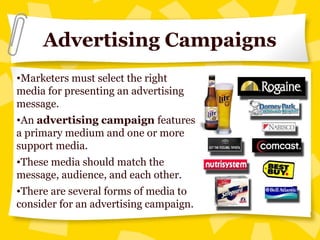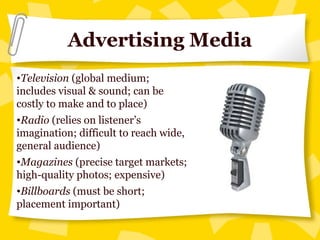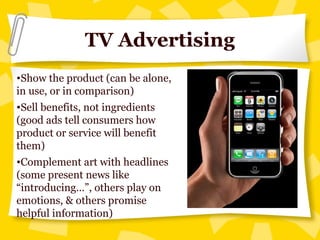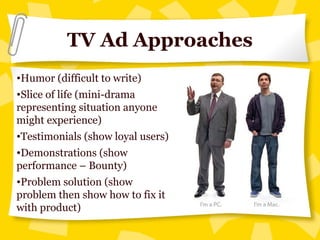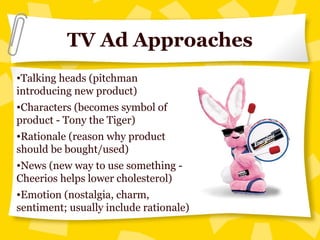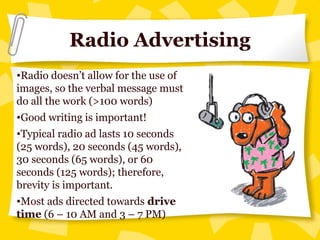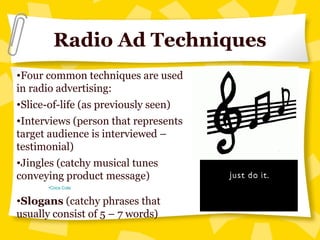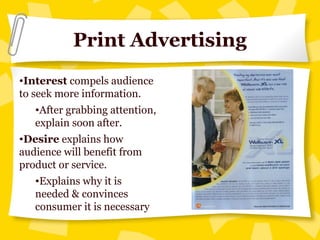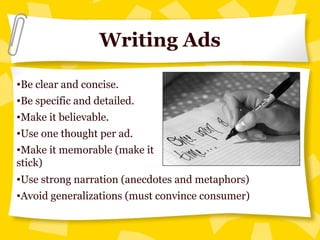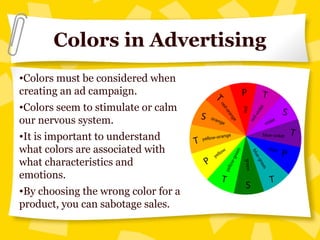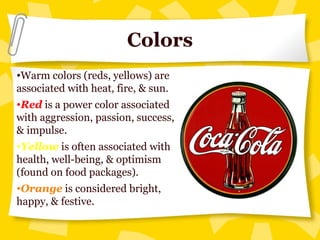4 advertising
- 1. Advertising Campaigns •Marketers must select the right media for presenting an advertising message. •An advertising campaign features a primary medium and one or more support media. •These media should match the message, audience, and each other. •There are several forms of media to consider for an advertising campaign.
- 2. Advertising Media •Television (global medium; includes visual & sound; can be costly to make and to place) •Radio (relies on listener’s imagination; difficult to reach wide, general audience) •Magazines (precise target markets; high-quality photos; expensive) •Billboards (must be short; placement important)
- 3. Advertising Media •Newspapers (local audience; smaller companies; promotional coupons; shorter “shelf life”) •Internet (worldwide reach; updates quick & inexpensive; difficult to reach target audience) •Specialty advertising (mall kiosks, brochures, clothing, Yellow pages, trailers in movies)
- 4. Media Mix •The media mix is the combination of media that an advertiser chooses for a campaign. •Ads on TV & Internet have greatest reach in America. •Advertisers must adjust ads to language and culture of target audience. •International ads must make sure message is presented as company intends. •In Mexico, Chevy model Nova could be mistaken for the Spanish phrase “no va” which means “don’t’ go.”
- 5. Visuals •A key element in developing advertisement is developing visual message. •This applies to both print & TV advertising. •Use simple images (too much background distracts; components should be easily recognizable) •Make instant connections (visual stereotypes)
- 6. TV Advertising •Show the product (can be alone, in use, or in comparison) •Sell benefits, not ingredients (good ads tell consumers how product or service will benefit them) •Complement art with headlines (some present news like “introducing…”, others play on emotions, & others promise helpful information)
- 7. TV Ad Approaches •Humor (difficult to write) •Slice of life (mini-drama representing situation anyone might experience) •Testimonials (show loyal users) •Demonstrations (show performance – Bounty) •Problem solution (show problem then show how to fix it with product)
- 8. TV Ad Approaches •Talking heads (pitchman introducing new product) •Characters (becomes symbol of product - Tony the Tiger) •Rationale (reason why product should be bought/used) •News (new way to use something - Cheerios helps lower cholesterol) •Emotion (nostalgia, charm, sentiment; usually include rationale)
- 9. Radio Advertising •Radio doesn’t allow for the use of images, so the verbal message must do all the work (>100 words) •Good writing is important! •Typical radio ad lasts 10 seconds (25 words), 20 seconds (45 words), 30 seconds (65 words), or 60 seconds (125 words); therefore, brevity is important. •Most ads directed towards drive time (6 – 10 AM and 3 – 7 PM)
- 10. Radio Ad Techniques •Four common techniques are used in radio advertising: •Slice-of-life (as previously seen) •Interviews (person that represents target audience is interviewed – testimonial) •Jingles (catchy musical tunes conveying product message) •Coca Cola •Slogans (catchy phrases that usually consist of 5 – 7 words)
- 11. Print Advertising •The basis of developing print advertising can be narrowed down to 5 components: attention, interest, desire, credibility, & action. •Attention is needed to communicate message to audience. •Use a headline & visual design •Repetition is key
- 12. Print Advertising •Interest compels audience to seek more information. •After grabbing attention, explain soon after. •Desire explains how audience will benefit from product or service. •Explains why it is needed & convinces consumer it is necessary
- 13. Print Advertising •Credibility must eliminate misunderstanding. •Be specific, concrete, & direct •Action is what you want audience to take. •Buying product, telling others, etc…
- 14. Logos •Logotypes or logos are often used in print advertising. •It helps the consumer identify the company or product. •It is usually large type at bottom of advertisement. •It can be name of company or perhaps a symbol.
- 15. Successful Logos •Successful logos become popular & memorable because they: •Differentiate •Are timeless •Evoke emotions •Are malleable (look good wherever) •Are simple •Have exposure (find it all over)
- 16. Writing Ads •Be clear and concise. •Be specific and detailed. •Make it believable. •Use one thought per ad. •Make it memorable (make it stick) •Use strong narration (anecdotes and metaphors) •Avoid generalizations (must convince consumer)
- 17. Colors in Advertising •Colors must be considered when creating an ad campaign. •Colors seem to stimulate or calm our nervous system. •It is important to understand what colors are associated with what characteristics and emotions. •By choosing the wrong color for a product, you can sabotage sales.
- 18. Colors •Warm colors (reds, yellows) are associated with heat, fire, & sun. •Red is a power color associated with aggression, passion, success, & impulse. •Yellow is often associated with health, well-being, & optimism (found on food packages). •Orange is considered bright, happy, & festive.
- 19. Colors •Cool colors (greens & blues) associated with sky, sea, & wilderness. •Blue is associated with tradition, orderliness, & stability. •Light blue is associated with cleanliness. •Dark blues appear to have calming effects.
- 20. Colors •Light green is associated with nature, regeneration, & self- preservation. •Green is associated with money. •Purple associated with royalty, elegance, expensive. •Violet associated with intimacy •White is color of purity and innocence.
- 21. Colors in Advertising •Black is unusual since it is considered mourning, but also ominous, as well as elegant. •Keep in mind that colors have different meanings in different cultures. •For example, in U.S. teachers tend to grade in red ink. •In Asian colors, this is considered highly offensive.

